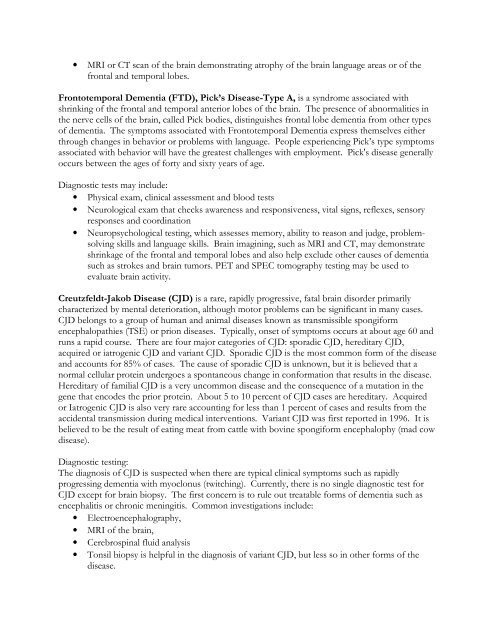Social Security Disability Insurance and young onset dementia: A ...
Social Security Disability Insurance and young onset dementia: A ...
Social Security Disability Insurance and young onset dementia: A ...
Create successful ePaper yourself
Turn your PDF publications into a flip-book with our unique Google optimized e-Paper software.
• MRI or CT scan of the brain demonstrating atrophy of the brain language areas or of the<br />
frontal <strong>and</strong> temporal lobes.<br />
Frontotemporal Dementia (FTD), Pick’s Disease-Type A, is a syndrome associated with<br />
shrinking of the frontal <strong>and</strong> temporal anterior lobes of the brain. The presence of abnormalities in<br />
the nerve cells of the brain, called Pick bodies, distinguishes frontal lobe <strong>dementia</strong> from other types<br />
of <strong>dementia</strong>. The symptoms associated with Frontotemporal Dementia express themselves either<br />
through changes in behavior or problems with language. People experiencing Pick’s type symptoms<br />
associated with behavior will have the greatest challenges with employment. Pick's disease generally<br />
occurs between the ages of forty <strong>and</strong> sixty years of age.<br />
Diagnostic tests may include:<br />
• Physical exam, clinical assessment <strong>and</strong> blood tests<br />
• Neurological exam that checks awareness <strong>and</strong> responsiveness, vital signs, reflexes, sensory<br />
responses <strong>and</strong> coordination<br />
• Neuropsychological testing, which assesses memory, ability to reason <strong>and</strong> judge, problemsolving<br />
skills <strong>and</strong> language skills. Brain imagining, such as MRI <strong>and</strong> CT, may demonstrate<br />
shrinkage of the frontal <strong>and</strong> temporal lobes <strong>and</strong> also help exclude other causes of <strong>dementia</strong><br />
such as strokes <strong>and</strong> brain tumors. PET <strong>and</strong> SPEC tomography testing may be used to<br />
evaluate brain activity.<br />
Creutzfeldt-Jakob Disease (CJD) is a rare, rapidly progressive, fatal brain disorder primarily<br />
characterized by mental deterioration, although motor problems can be significant in many cases.<br />
CJD belongs to a group of human <strong>and</strong> animal diseases known as transmissible spongiform<br />
encephalopathies (TSE) or prion diseases. Typically, <strong>onset</strong> of symptoms occurs at about age 60 <strong>and</strong><br />
runs a rapid course. There are four major categories of CJD: sporadic CJD, hereditary CJD,<br />
acquired or iatrogenic CJD <strong>and</strong> variant CJD. Sporadic CJD is the most common form of the disease<br />
<strong>and</strong> accounts for 85% of cases. The cause of sporadic CJD is unknown, but it is believed that a<br />
normal cellular protein undergoes a spontaneous change in conformation that results in the disease.<br />
Hereditary of familial CJD is a very uncommon disease <strong>and</strong> the consequence of a mutation in the<br />
gene that encodes the prior protein. About 5 to 10 percent of CJD cases are hereditary. Acquired<br />
or Iatrogenic CJD is also very rare accounting for less than 1 percent of cases <strong>and</strong> results from the<br />
accidental transmission during medical interventions. Variant CJD was first reported in 1996. It is<br />
believed to be the result of eating meat from cattle with bovine spongiform encephalophy (mad cow<br />
disease).<br />
Diagnostic testing:<br />
The diagnosis of CJD is suspected when there are typical clinical symptoms such as rapidly<br />
progressing <strong>dementia</strong> with myoclonus (twitching). Currently, there is no single diagnostic test for<br />
CJD except for brain biopsy. The first concern is to rule out treatable forms of <strong>dementia</strong> such as<br />
encephalitis or chronic meningitis. Common investigations include:<br />
• Electroencephalography,<br />
• MRI of the brain,<br />
• Cerebrospinal fluid analysis<br />
• Tonsil biopsy is helpful in the diagnosis of variant CJD, but less so in other forms of the<br />
disease.








